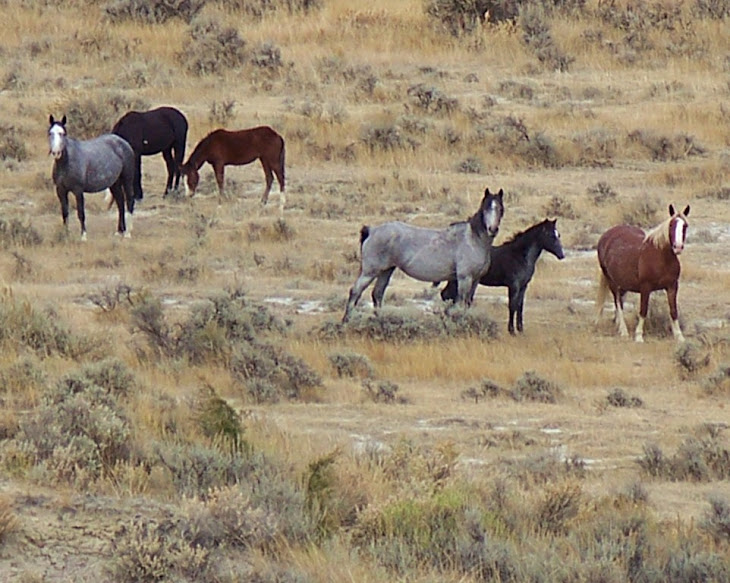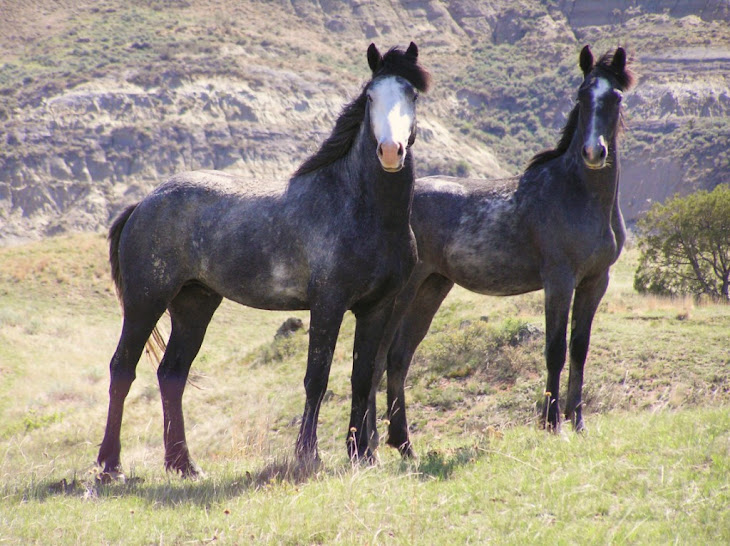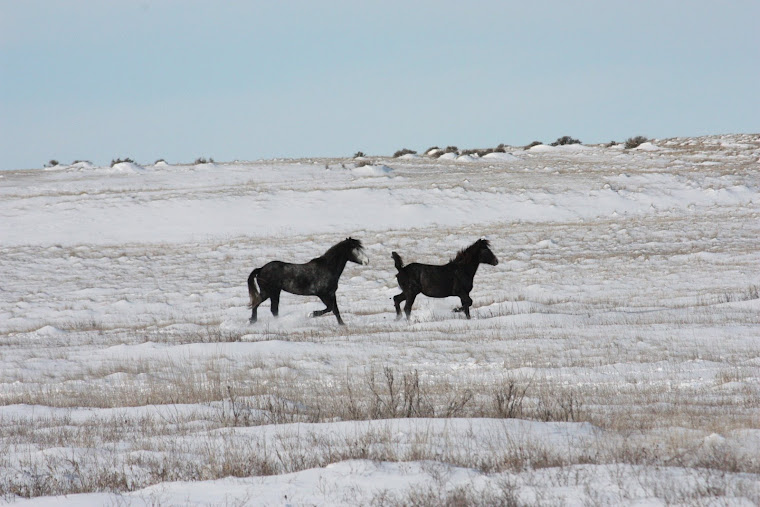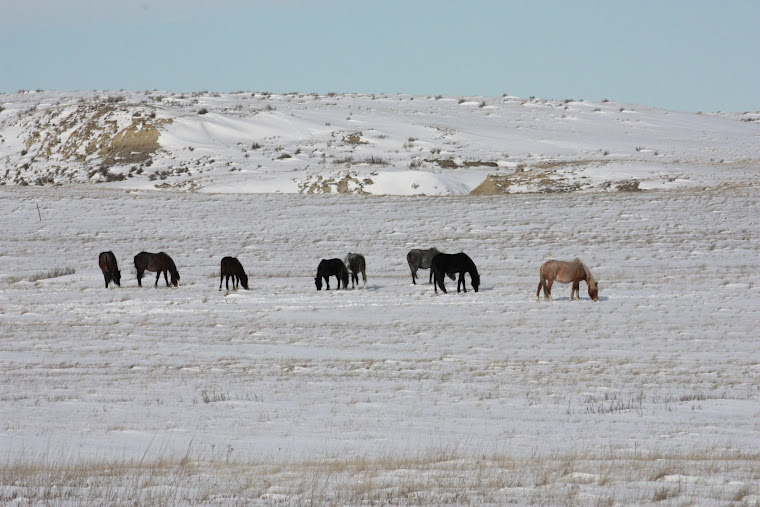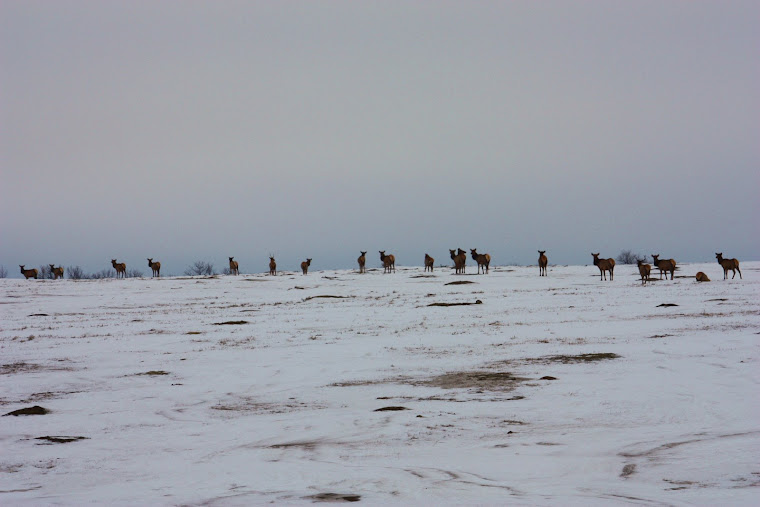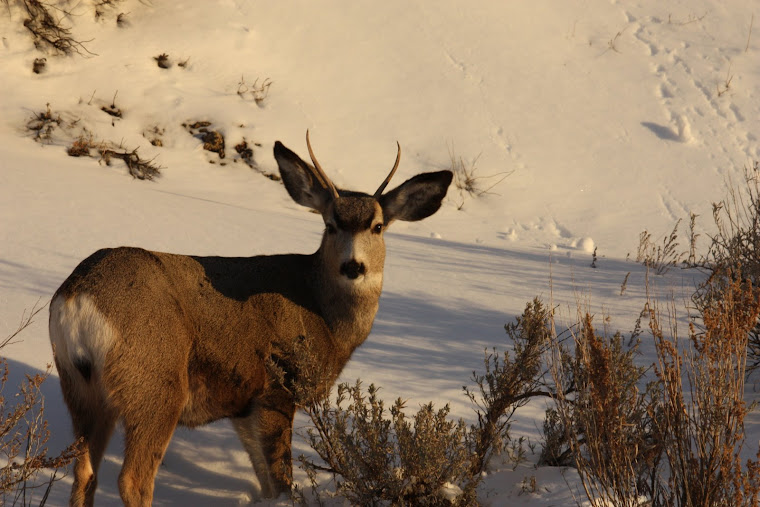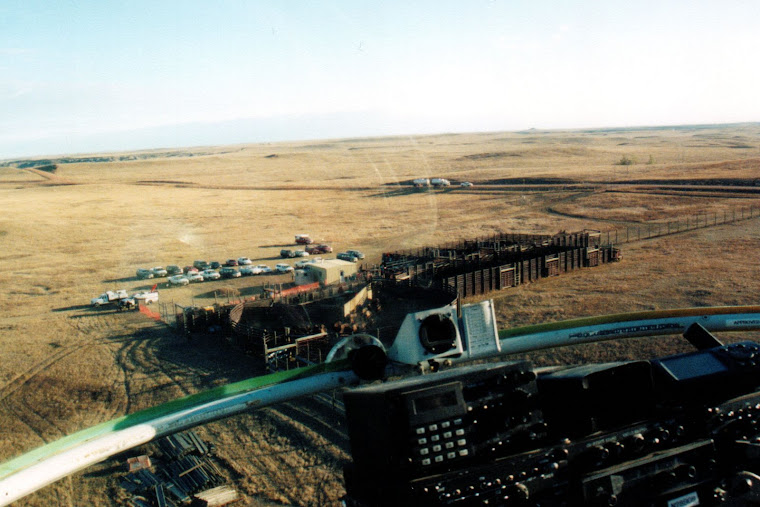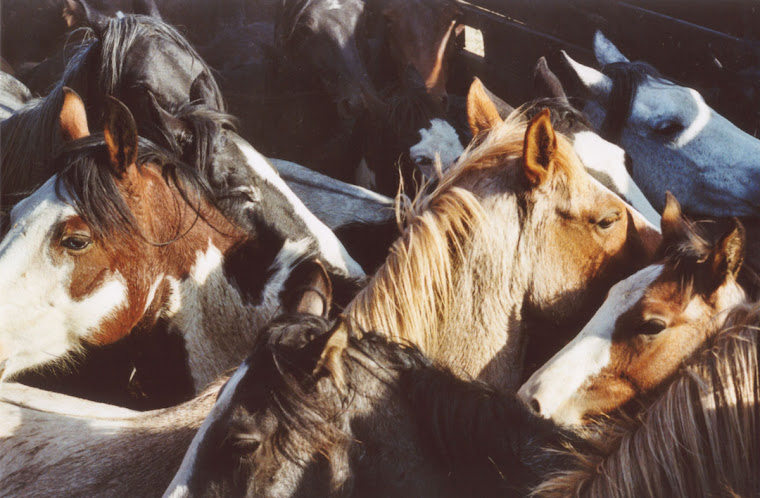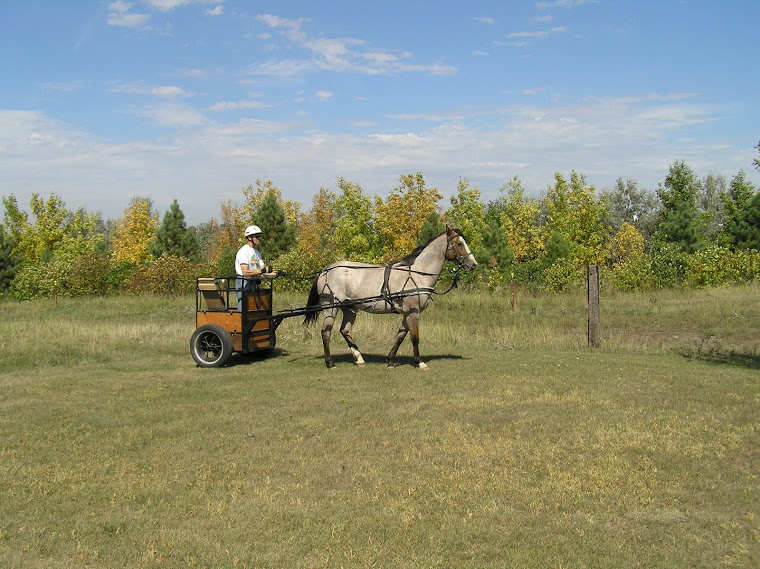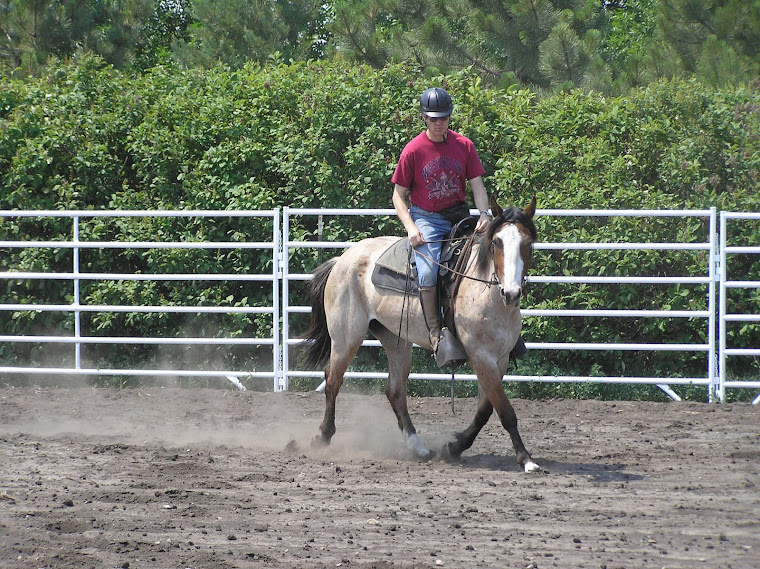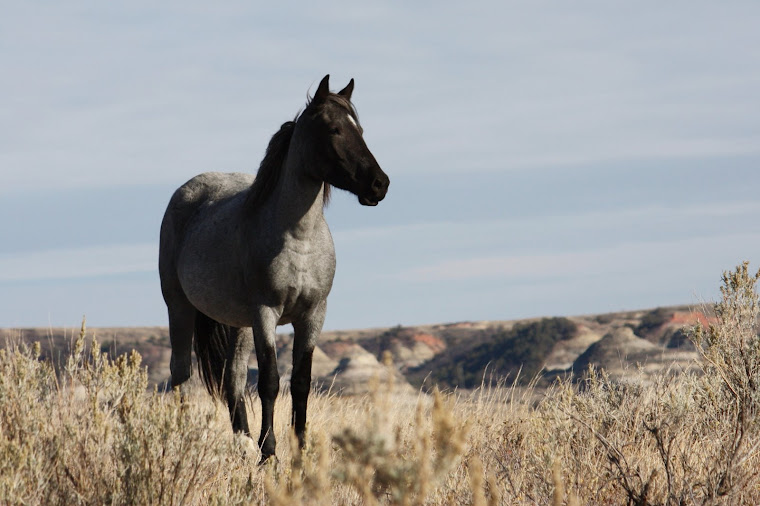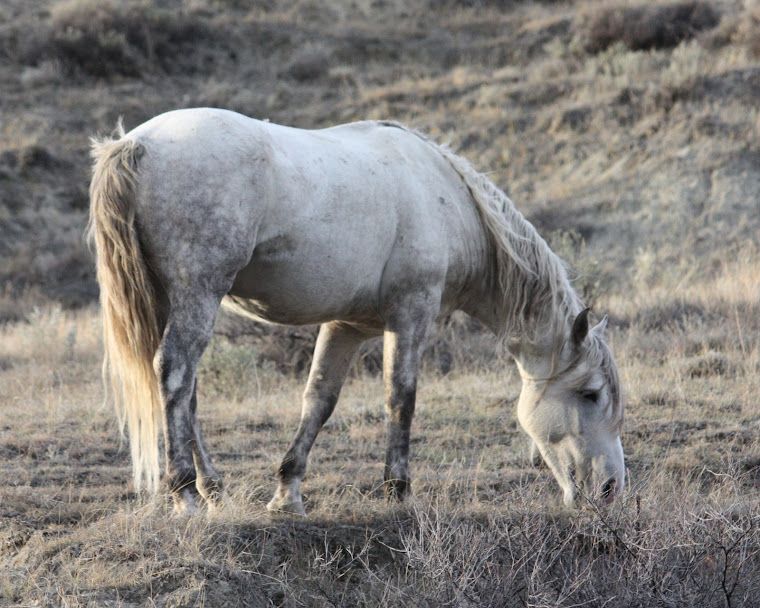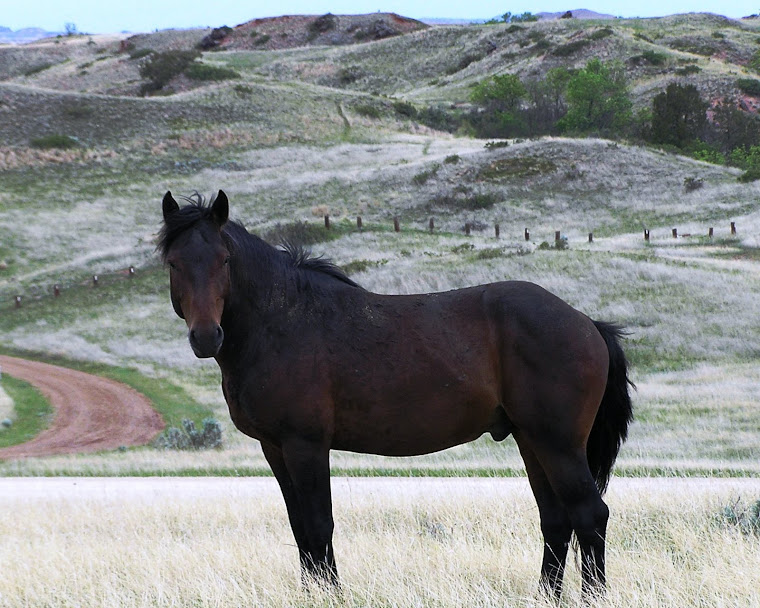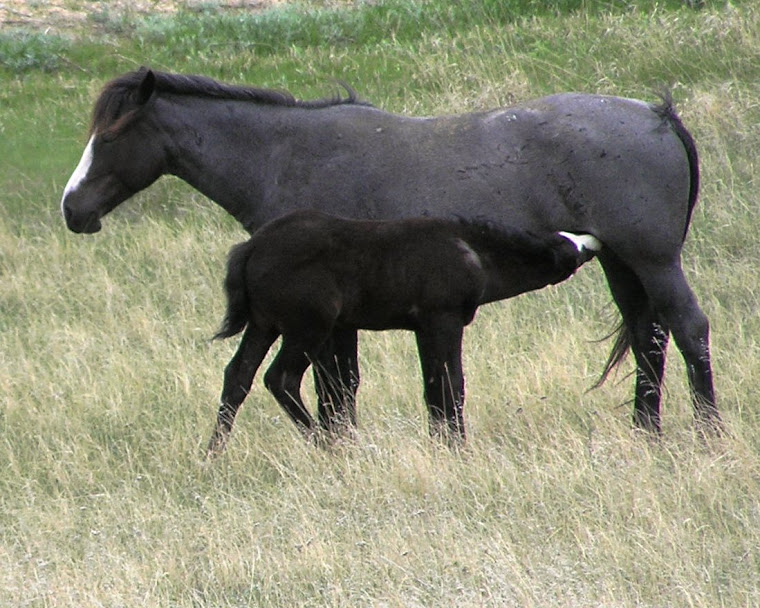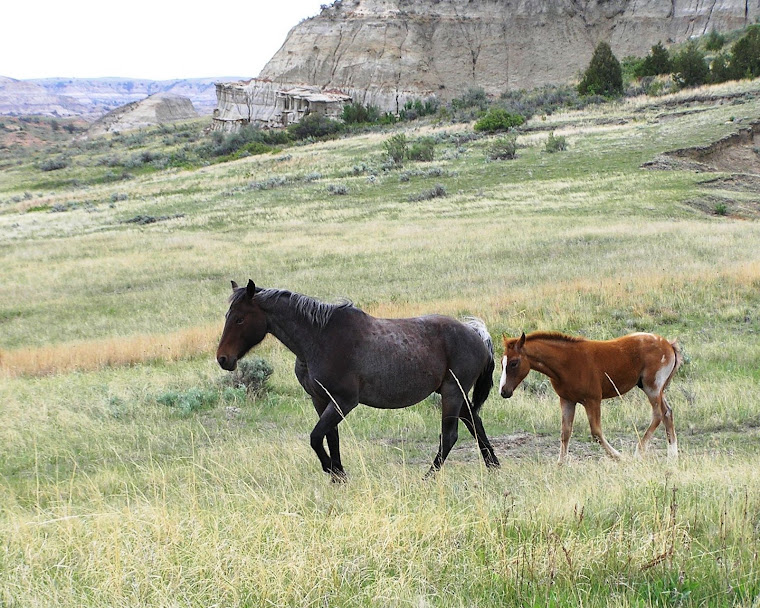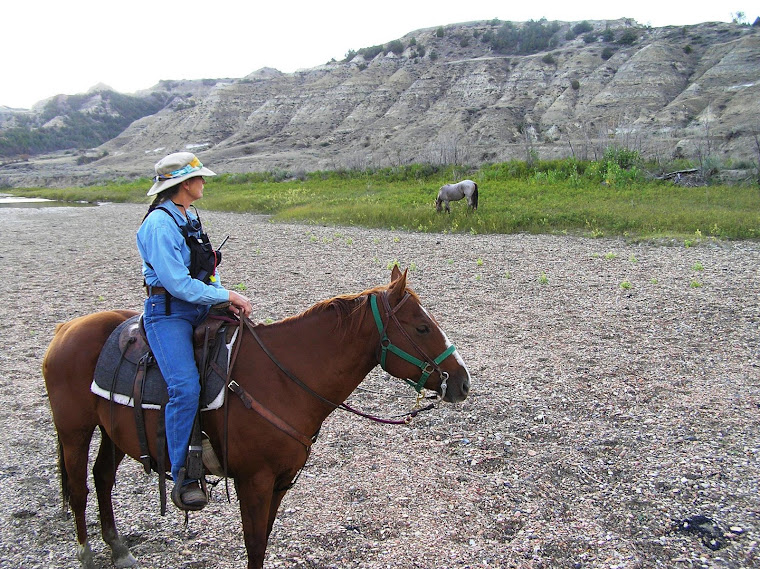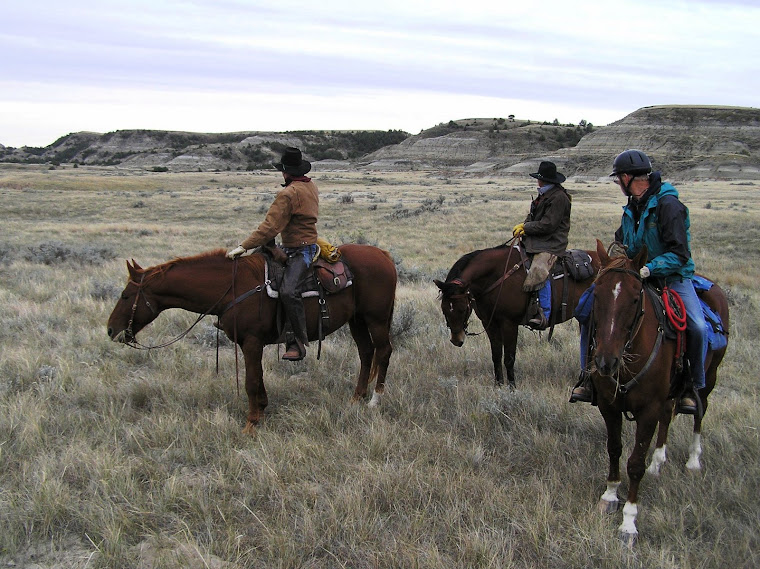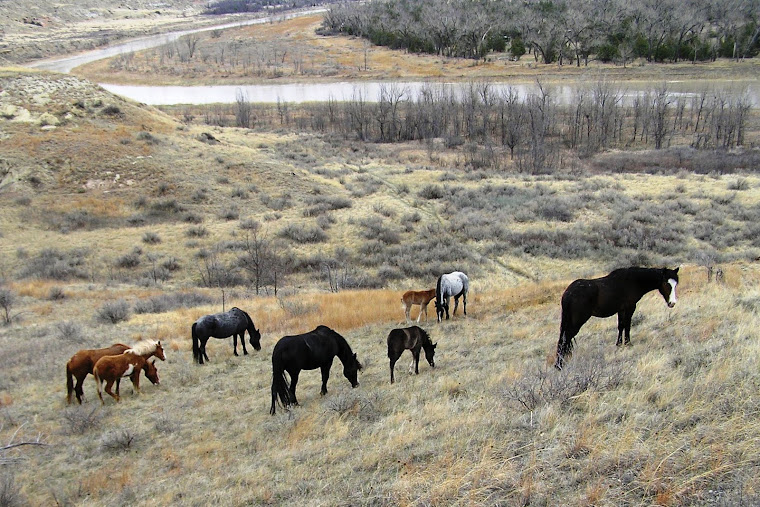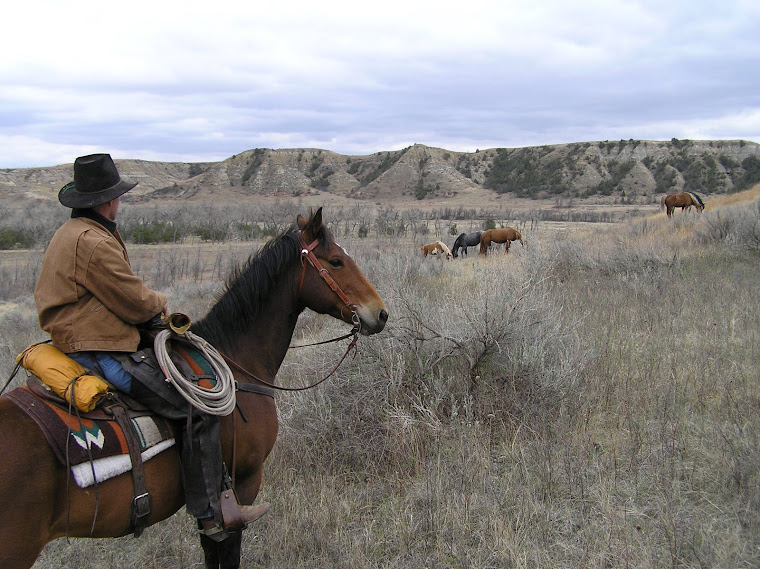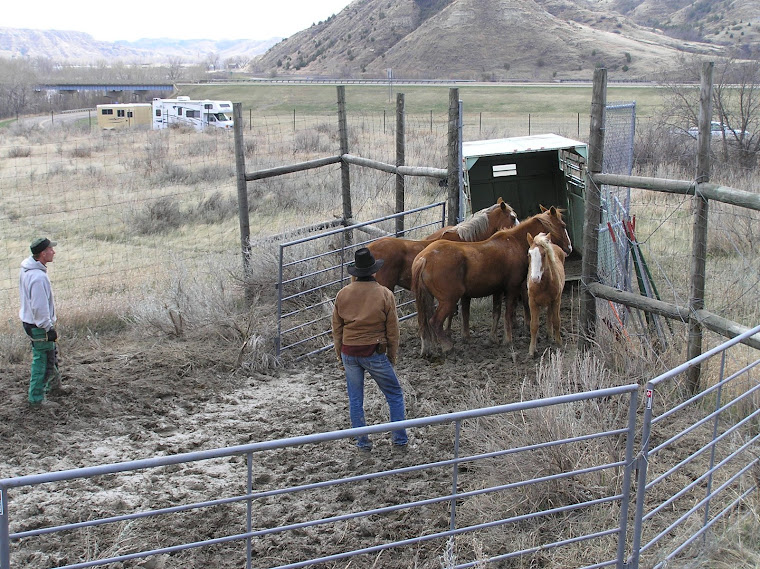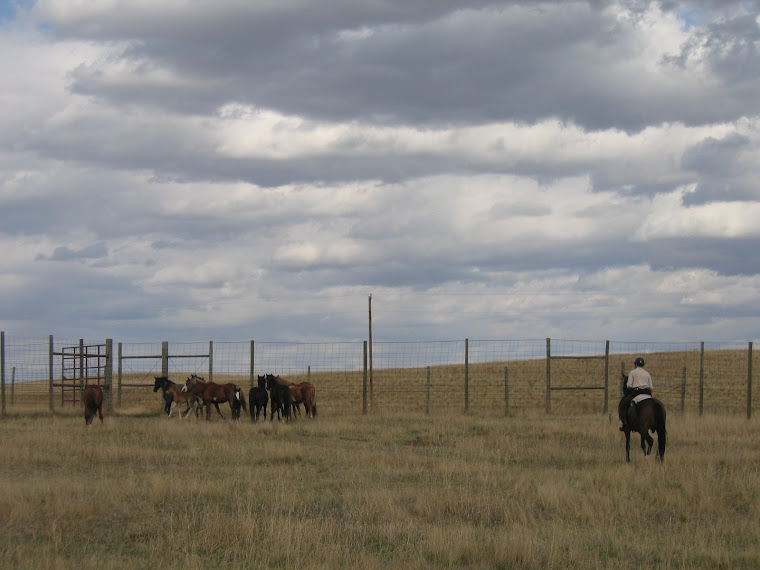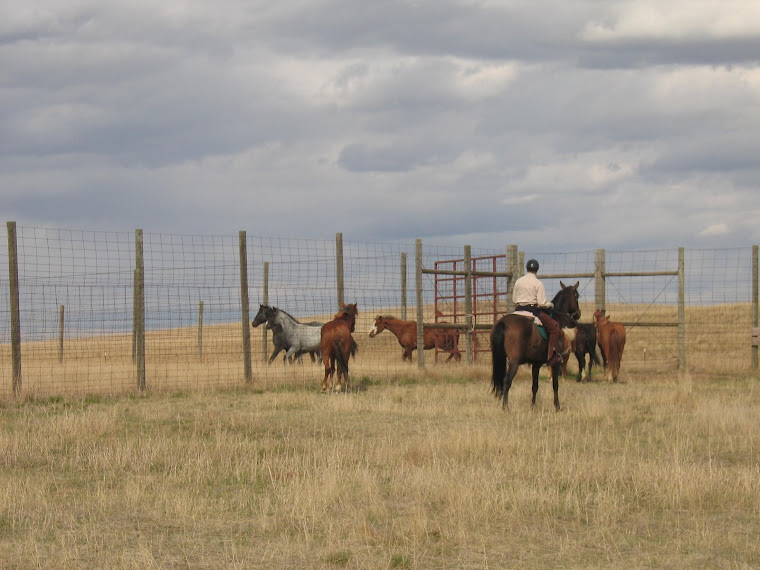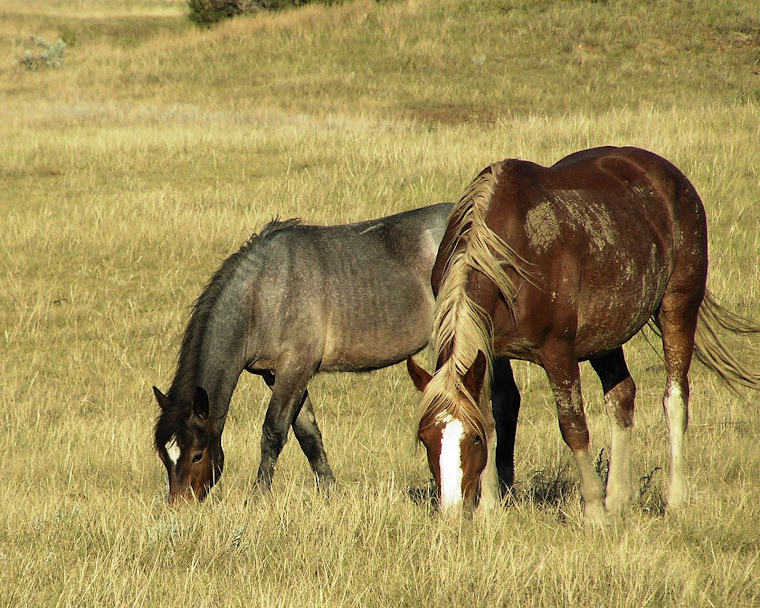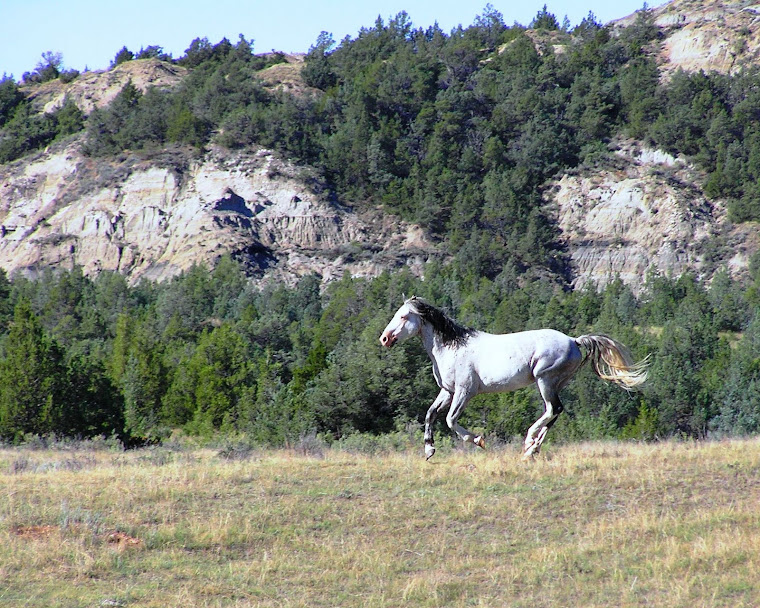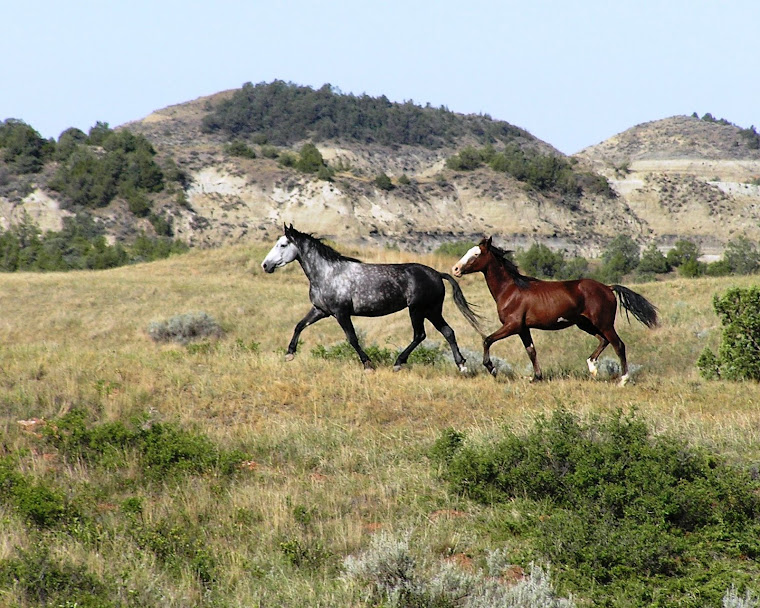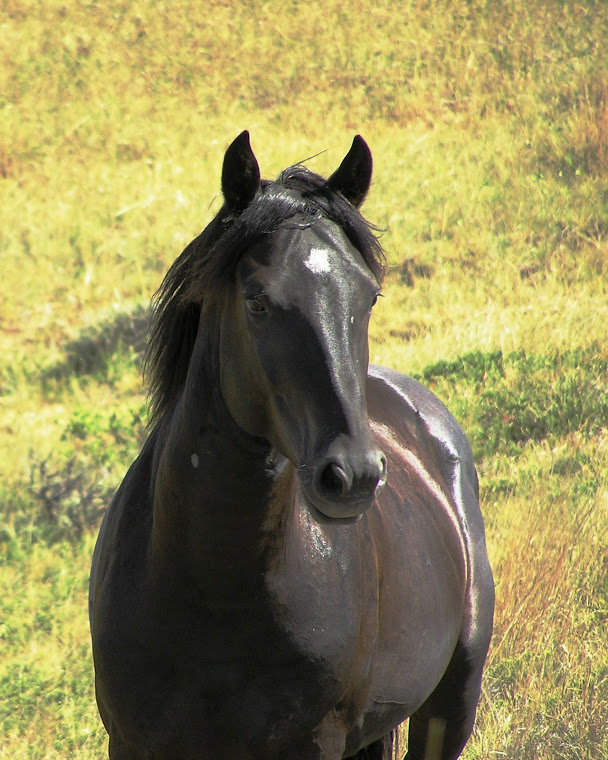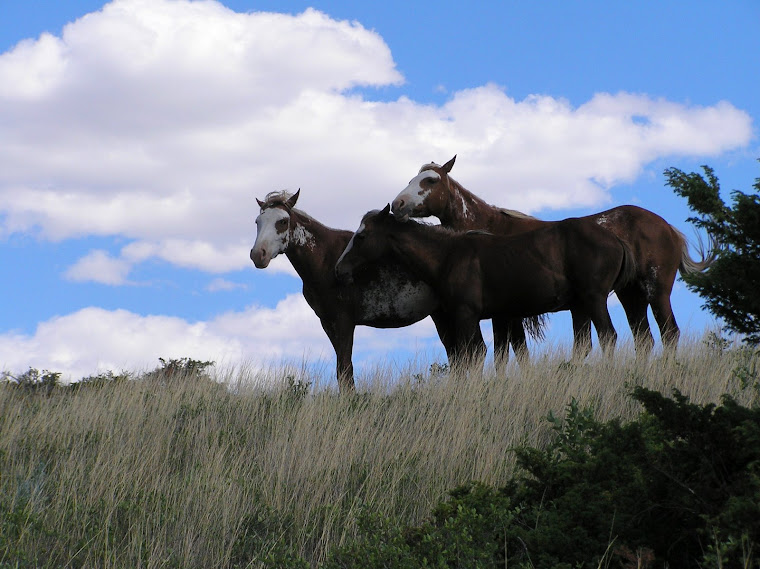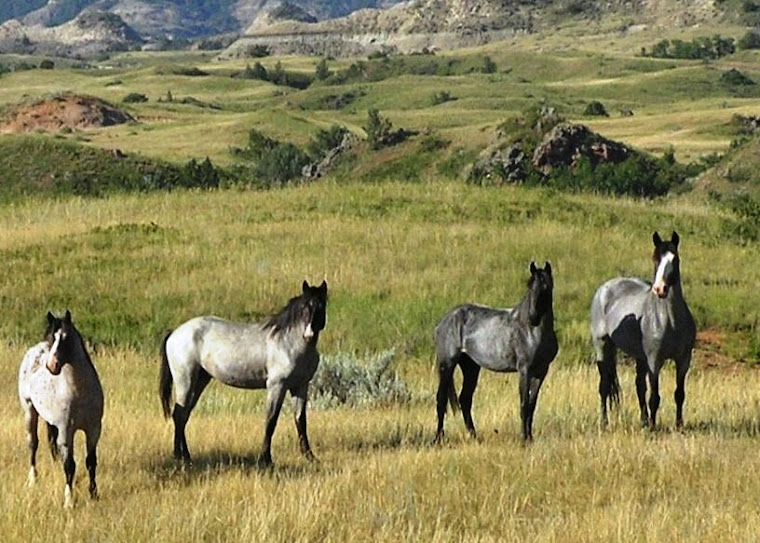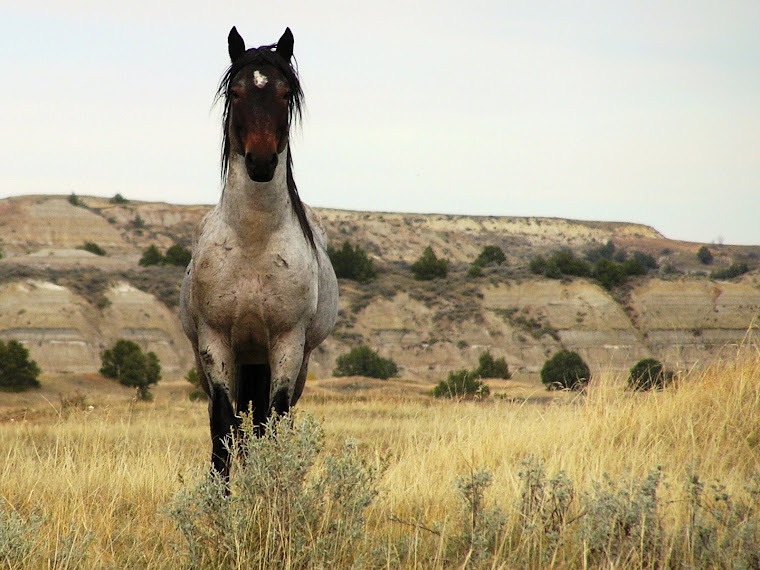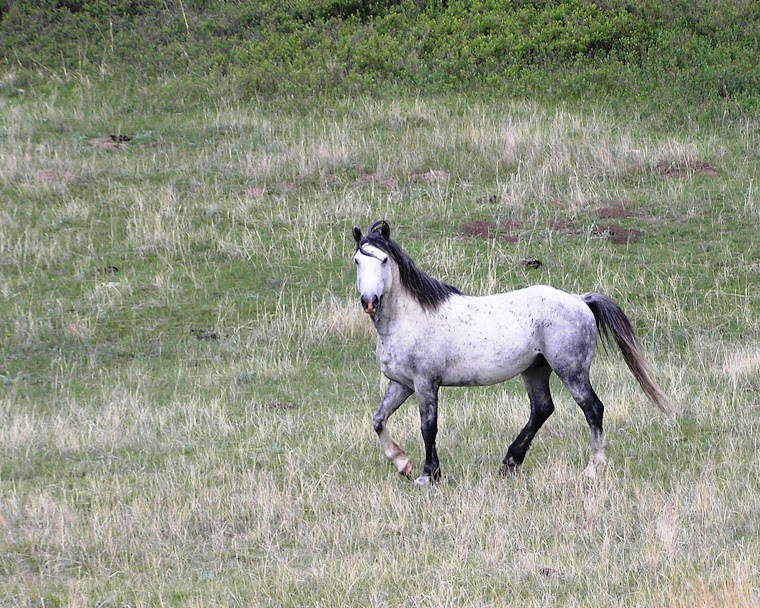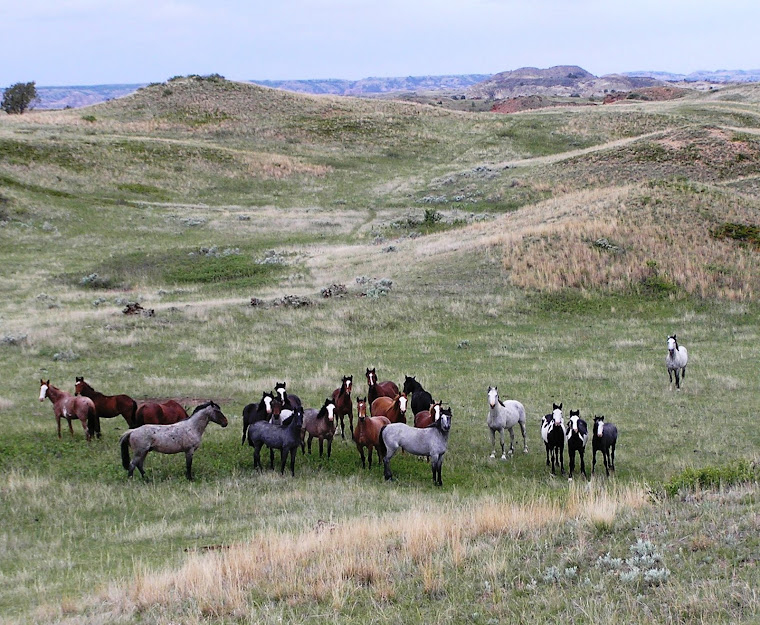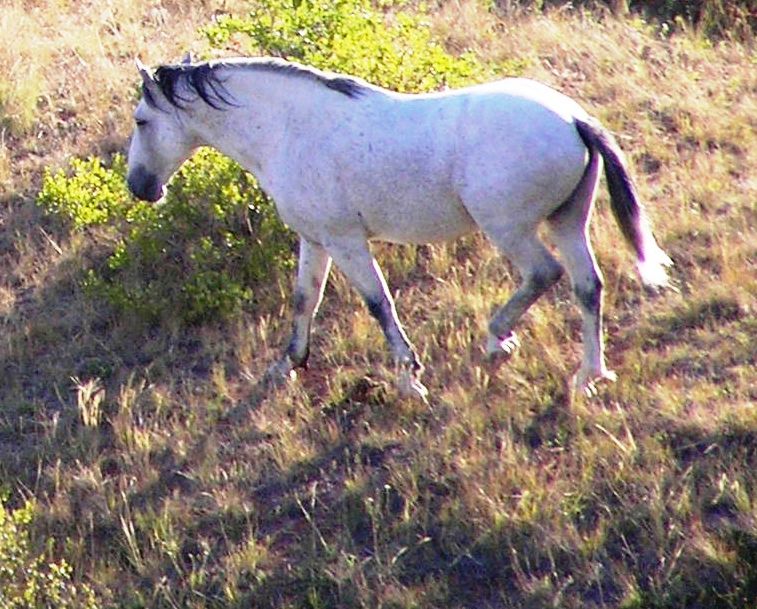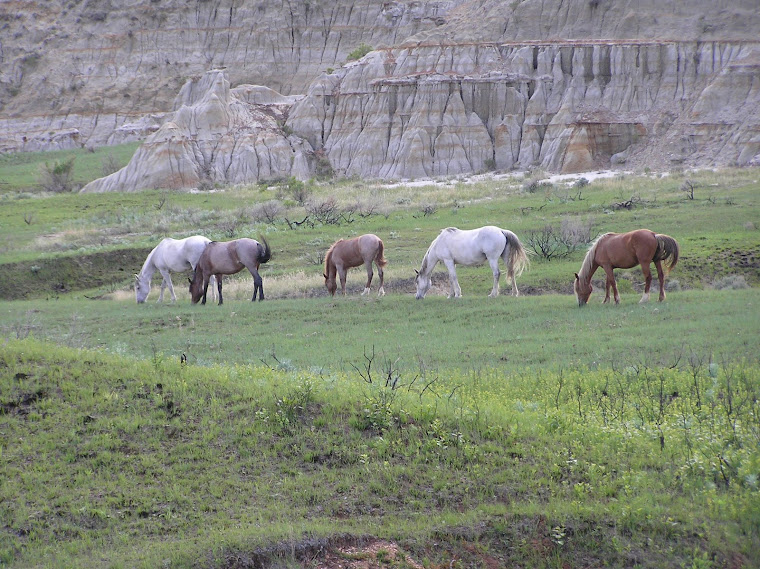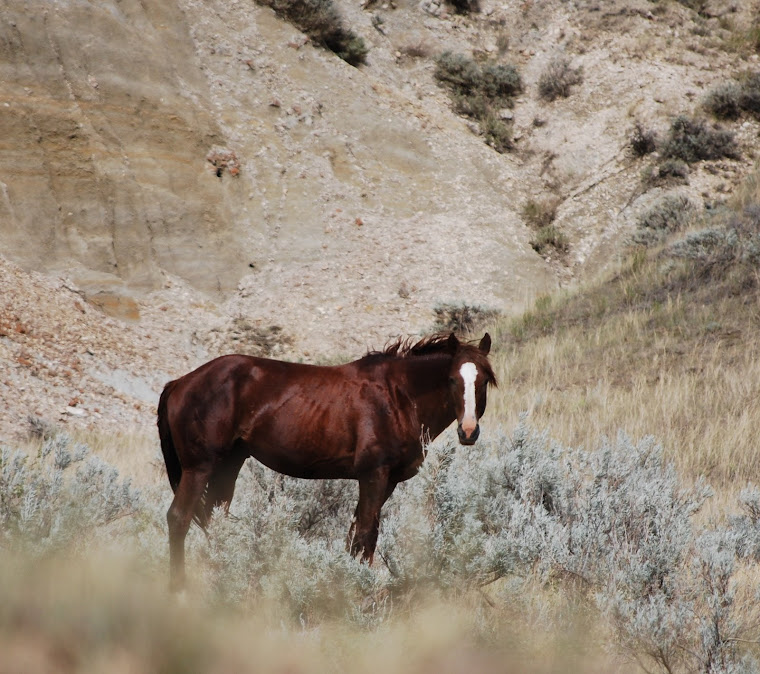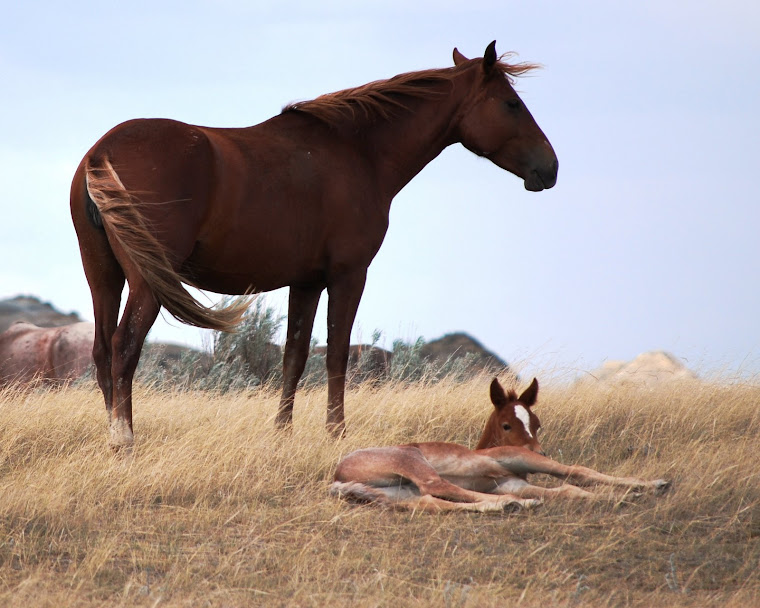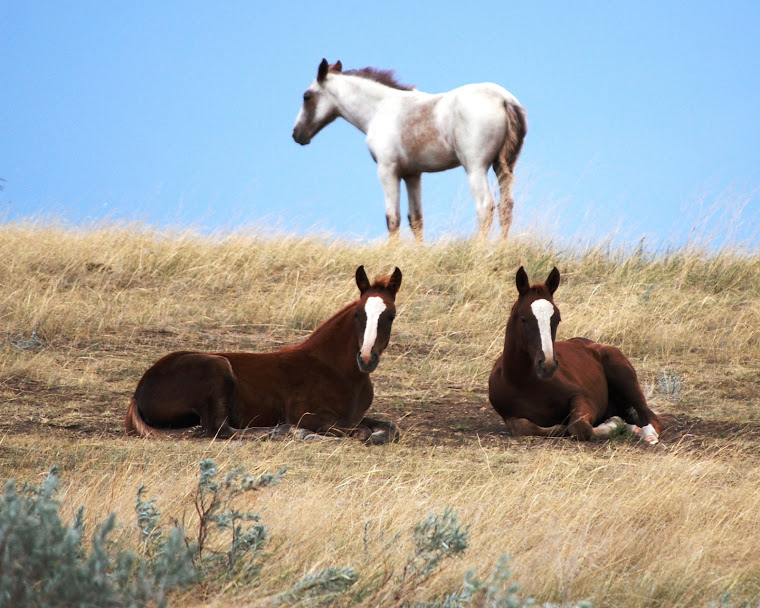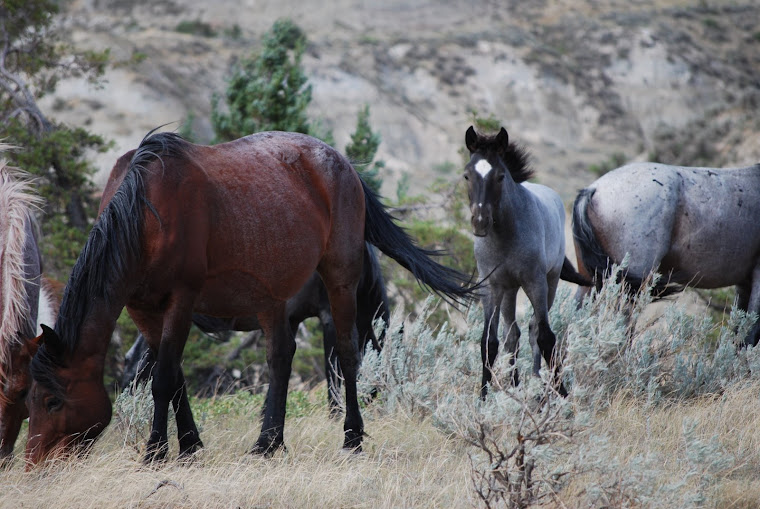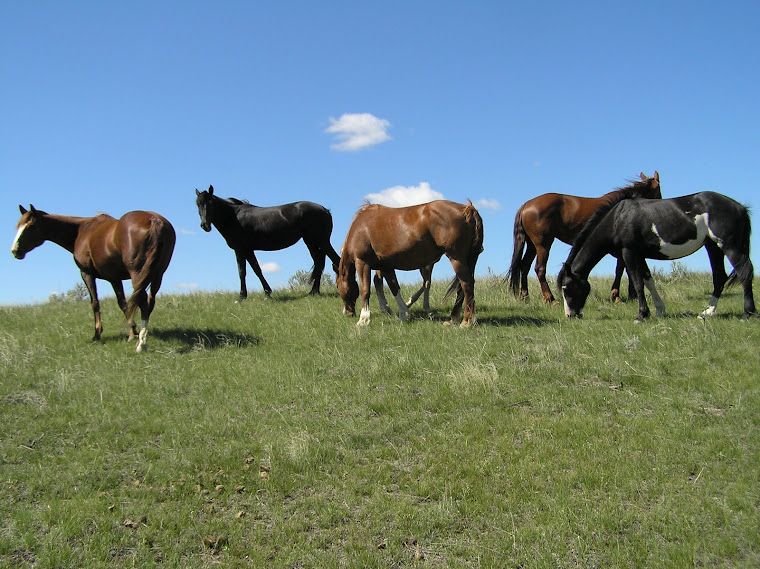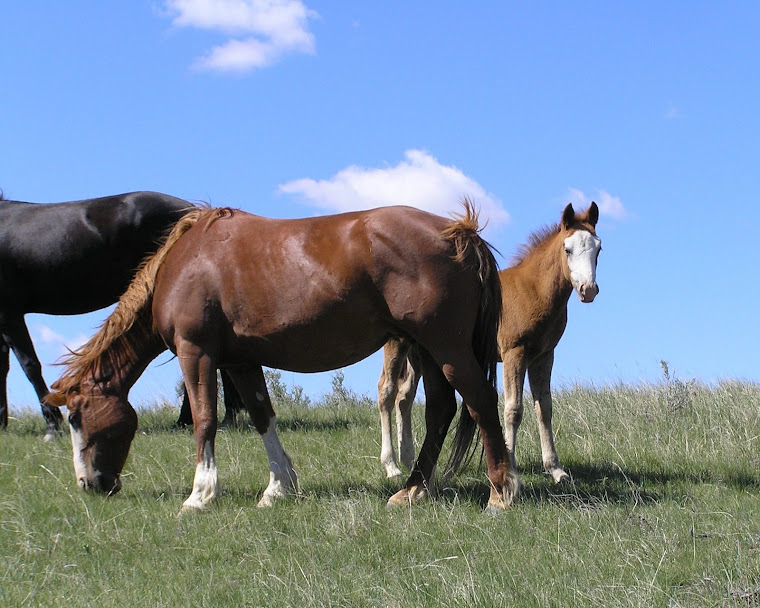Though, because of the weather and unexpected budget cuts, the 2011 observations have been a challenge for all involved, I have seen some rewarding behaviors with the bands. Thunder and his mares are most often a challenge to get close enough to evaluate for condition and pregnancy. They have been coming up on the flats on the east side of the park quite regularly, so it pays to be patient and wait for them to appear on top and avoid having to search for them in the breaks below. On a warm morning in April, I found them grazing near the southeast corner. Not wanting to disturb them, I walked in to about 200 yards and sat down with my scope to get a behavioral observation. It is impossible to see them on the upper flats without them seeing you, but even though they had seen me come in, they were OK with me watching from that distance. The mares quietly moved along as they munched what they could find of the new green grass just poking through. Though I was sure Thunder had seen me walk in and sit down, after about 20 minutes, he decided to check who this new intruder was. We don't like to see any reaction to our presence, but it was not to be avoided that morning. Thunder trotted around me to the north to get down wind of me and get a better look. Usually, if he approaches, he comes alone, but this time the mares and yearlings started to follow. In family groups they trotted past me and formed a semi-circle east of me about thirty feet away. I just sat on the ground snapping pictures as they, all lined up side by side, looked at me as if the question what I was up to sitting out in their new grass. After a few minutes they walked away and resumed their grazing. It was a rare visit by some of the most skittish mares in the park and I relished the gift they had just given me.
One of my other challenges earlier this spring was to find Sidekick to record any new foals. Sidekick and his band had been hanging in the area east and southeast of Buck Hill most of the last month. Generally a team would go in on horseback since it is a long hike from anywhere, but I didn't have my horse with me this trip. Earlier, one of the Biologists had seen Bella from afar and determined that she was close to foaling. I wanted to check on her so started in from the east side. Sidekick saw me, but was unconcerned, but when Bella saw me, she moved off to the west with her new foal. I sat down and started a study with them. They were moving among the breaks and sagebrush, so it was difficult to see them all from my distance. I had to get a little closer. Sidekick had moved to the bottom of a clay butte to the left while his mares grazed on either side of a butte to the right. My only way to see them all was to try to get on higher ground. Since Sidekick was paying no attention to me, I headed for a rise beyond him. Bella, by that time had settled in to grazing. I was able to get to the small rise and sit down to wait for the other mares to come over the top and join Bella. As I hoped, the other mares gradually came my way over the small butte to graze with Sidekick and Bella on my side of the butte. I was now committed to stay where I was because I did not want to frighten them. I was able to start a new observation while Bella and her new foal laid down and slept about 60 feet from me. Still not wanting to frighten them and needing to determine the sex on the foal, I waited until the foal rose to nurse. The little filly pestered her dam until Bella stood and allowed her to nurse. Bella then turned and brought her week old filly within 30 feet of me as if she knew I wanted to get a photo of this pretty little bay. After they had moved off and Mist had allowed me to determine that she was close to foaling, I walked back out the way I had come, marveling at how trusting these horses are of me. I truly think they remember those who have tracked them in the past and sometimes even welcome us into their herd. The little filly's name is Larkspur.
On that same trip, I saw Sidekick and his band from Buck Hill one cold snowy morning. There was a new foal, so I had to slide down Buck Hill to check out this new baby of Mist's. They were in the exact place where Eileen and I had been caught in the terrible storm that had damaged 100 home in Dickinson a couple years earlier. This time the ground was sloppy with melting snow. I didn't take time for a study this time but walked in so they could see me and know I meant no harm. To my surprise, I realized it was Ember's Girl who had foaled, not Mist. The little foal was very new and miserably cold. Every time it tried to lay down, it would immediately get up again because of the cold snow. I was able to get close enough to get a photo by kneeling in the snow, but since it was a dark, cold day and a dark foal, I was having trouble telling the sex. After Sidekick had come by to check me out, I finally got on my stomach to get a shot of the little one's under side. Having me flat on the ground upset Embers' Girl and she uttered a strange alarm, so I popped back up again. She was fine with me again as long as I stayed upright. Checking my photos confirmed that the new foal was a colt. I thanked Embers' Girl for her patience and headed back to the top of Buck Hill through the muck and up the slippery slope to the car. We called the colt Hawthorn.
Another week, after our riding team had covered the whole area by horseback and never seen them, I walked to the east rim with a scope was lucky enough to find them on top of a flat butte. Al had ridden on that butte the day before, but no ones knows where they were hiding. Again I took off on foot for the bottoms southeast of Buck Hill. This time I could see them from quite a distance without them seeing me, so I started a study while walking in. I could see that the expected foal from Mist had been born and Mist was already in her foal heat. I was struggling to see all of them so decided to move around the south to higher ground and have a better angle on them. Unfortunately, by the time I got to my vantage point, they were coming down for water. I had to retrace my steps and get an advantage from another small butte. Mist and Snip's Gray were uneasy seeing me there, but there was nowhere else for me to go where I could see them. I sat down to east my lunch and wait them out. I was finally able to get my 30 minute observation just before they moved behind another small butte. Knowing I didn't have time to find any other bands that day, I decided to go in to determine the sex of Mist's foals and maybe get a photo. I carefully crawled onto a tiny outcropping and watched as they grazed. Eventually they were on all sides of me, seeing me, but now not caring that I was close enough to photograph the foals. I was able to photograph tiny Primrose, one of Ember's last foals, a cute bay roan filly.
In all of these instances, the horses accepted me when I was patient and allowed them to see and smell who and what I was. These experiences are gifts that I will never forget. There is nothing like the feeling of acceptance by these marvelous animals.
Wednesday, June 1, 2011
Friday, April 22, 2011
THE STUDIES AND STRUGGLES OF 2011
The feral horse studies of 2011 have been difficult and frustrating with the weather and ground conditions in the Park this spring. Though we were supposed to began the study in March in order to find all the foals, we were held back by storm after storm. It would be safe to say that there has been a snow storm at least once a week since our target date of March 15. With only one full time person, our new tracker and office manger, Maggie, it has been a daunting challenge to even find all the bands. If not for the help of the Biologists, Mike and Wade, we would still be looking for some of the more remote bands, since it has been so wet that even Al and his horses were prevented from getting out.
With the hard work of the biologists, Maggie, Al, Jennifer, Henry and me all the bands have been accounted for and, to date, 12 foals have been found. Most of the bands were as they had been when we finished the 2010 observations in November, but there have been some changes, as there always are. Embers, the oldest stallion in the park, has lost his two mares, Bella and Mist, to the younger stallion, Sidekick. Bella has already dropped a pretty bay filly, Larkspur, that should roan like her sire, and Mist was about to pop the last time I saw her. Sidekick's mare, Embers' Girl has a new colt named Hawthorn.
Some of the red roan mares appeared to be trying to play some tricks on our trackers early this spring. There was a red roan mare with Mystery that they assumed was Shale, who had a yearling filly with a star with her, but the red roan mare from Gray Ghost's band, Ginger, was missing her yearling filly with a star and Nordie, the red roan mare from Little Sorrel's band, was nowhere to be found. They also had seen a few horses that didn't seem to fit the description of any of the bands. Maggie had never been able to get close enough to them to identify who they were, but they had a new dark foal with them.
When I was finally able to get out, we were able to figure out the puzzle. The unknown band turned out to be Smokey and Shale from Mystery's band along with Shale's yearling filly, Teepee. Smokey had a new foal that we called Crocus. Then who were the red roan mare and yearling filly with the star now in Mystery's band? Finding them again that day, we were able to determine that they were Ginger and her filly, Whiskey, from Gray Ghost's band. There was only one more piece of the puzzle to figure out; the red roan mare with Gray Ghost had to be the missing Nordie!
With all of that mix up straightened out, we were able to determine that we had only lost one horse over the long, cold winter. The broken, Randy, who had been badly injured in stallion fights, had finally succumbed to the draining task of digging for grass through the deep snow. It was a blessing for him to finally die.
It wasn't long before the horses started playing their tricks again, but this time Maggie was on to them. Nordie somehow found her way back to Little Sorrel and was replaced in Gray Ghost's band by the dark red roan mare, Tanker. It must have been a pretty intense fight between Little Sorrel and Gray Ghost, because Tanker was Little Sorrel's darling who stuck to him like glue. One day I was watching Gray Ghost's band and thinking how boring they were making my job; the next day he had taken the two mares Mystery had lost. I had seen Mystery running from the area, but the emaciated Gray Ghost had been strong enough to win the mares. By then, Shale also had a new foal, a bay filly we called Lupine, but Smokey's foal turned out to be a colt, not a filly, so we had to change his name to Prairie Smoke.
We gave the name Crocus to a beautiful flaxen chestnut foal out of Flame until I saw the foal up close and found out that Crocus was also a colt! We named him Flax! Two other foals in the Double band are Frosty's Fool, a cute black filly born on April 1st, and Indian Paintbrush, a bay filly out of Pretty Girl.
The two latest foals hadn't been named yet but our very first foal was out of Raven, the pretty little Esprit. Another one of Mystery's mares, Cheyenne, had an extremely active little bay filly, Sumac. Copper continued passing his color on in his new filly, Buttercup, out of River.
I will soon add photos at the bottom of this blog, but 10 of the foals are up on the North Dakota Badlands Horse Registry page on Facebook.
With the hard work of the biologists, Maggie, Al, Jennifer, Henry and me all the bands have been accounted for and, to date, 12 foals have been found. Most of the bands were as they had been when we finished the 2010 observations in November, but there have been some changes, as there always are. Embers, the oldest stallion in the park, has lost his two mares, Bella and Mist, to the younger stallion, Sidekick. Bella has already dropped a pretty bay filly, Larkspur, that should roan like her sire, and Mist was about to pop the last time I saw her. Sidekick's mare, Embers' Girl has a new colt named Hawthorn.
Some of the red roan mares appeared to be trying to play some tricks on our trackers early this spring. There was a red roan mare with Mystery that they assumed was Shale, who had a yearling filly with a star with her, but the red roan mare from Gray Ghost's band, Ginger, was missing her yearling filly with a star and Nordie, the red roan mare from Little Sorrel's band, was nowhere to be found. They also had seen a few horses that didn't seem to fit the description of any of the bands. Maggie had never been able to get close enough to them to identify who they were, but they had a new dark foal with them.
When I was finally able to get out, we were able to figure out the puzzle. The unknown band turned out to be Smokey and Shale from Mystery's band along with Shale's yearling filly, Teepee. Smokey had a new foal that we called Crocus. Then who were the red roan mare and yearling filly with the star now in Mystery's band? Finding them again that day, we were able to determine that they were Ginger and her filly, Whiskey, from Gray Ghost's band. There was only one more piece of the puzzle to figure out; the red roan mare with Gray Ghost had to be the missing Nordie!
With all of that mix up straightened out, we were able to determine that we had only lost one horse over the long, cold winter. The broken, Randy, who had been badly injured in stallion fights, had finally succumbed to the draining task of digging for grass through the deep snow. It was a blessing for him to finally die.
It wasn't long before the horses started playing their tricks again, but this time Maggie was on to them. Nordie somehow found her way back to Little Sorrel and was replaced in Gray Ghost's band by the dark red roan mare, Tanker. It must have been a pretty intense fight between Little Sorrel and Gray Ghost, because Tanker was Little Sorrel's darling who stuck to him like glue. One day I was watching Gray Ghost's band and thinking how boring they were making my job; the next day he had taken the two mares Mystery had lost. I had seen Mystery running from the area, but the emaciated Gray Ghost had been strong enough to win the mares. By then, Shale also had a new foal, a bay filly we called Lupine, but Smokey's foal turned out to be a colt, not a filly, so we had to change his name to Prairie Smoke.
We gave the name Crocus to a beautiful flaxen chestnut foal out of Flame until I saw the foal up close and found out that Crocus was also a colt! We named him Flax! Two other foals in the Double band are Frosty's Fool, a cute black filly born on April 1st, and Indian Paintbrush, a bay filly out of Pretty Girl.
The two latest foals hadn't been named yet but our very first foal was out of Raven, the pretty little Esprit. Another one of Mystery's mares, Cheyenne, had an extremely active little bay filly, Sumac. Copper continued passing his color on in his new filly, Buttercup, out of River.
I will soon add photos at the bottom of this blog, but 10 of the foals are up on the North Dakota Badlands Horse Registry page on Facebook.
Sunday, March 13, 2011
The NORTH DAKOTA BADLANDS HORSE

In the fall of 2009, when we knew as many as 90 horses could be destined for removal from the Park and could be sold at public auction, my husband and I started an organization for these horses. The North Dakota Badlands Horse Registry was established to recognize, appreciate, promote, and register the the horses that were sold from the Park in that 2009 sale as well as any sold at past and future TRNP sales. To explain why we would want to start a new registry, I will give some history of these horses.
The horses from TRNP have a long and colorful history; they carry the blood of hundreds and thousands of wild and domestic horses who came before them. For centuries their heritage parallelled that of other wild horses in America. After being brought to the new world by the Spaniards, many horses escaped, reproduced, and dispersed. They soon caught the attention of the indigenous peoples of Central and North America who recognized the advantage of speed, strength, and stamina that horses could give them in daily life, hunting, and battle. The horse changed the lives of native people forever. When early American explorers and settlers brought more imported horses with them, either by intent or accidental breeding, these larger European horses interbred with the sturdy Mustangs and spread throughout the continent.
Early horses running in the North Dakota badlands carried traits of the Mustangs as well as those of horses brought by ranchers and farmers when they settled the area. At the time when the US Army was involved in various skirmishes with the Mexicans and Indians, horses were also bred in the badlands as Army remounts. As horses lost their popularity and grazing lands in other parts of the country, and farmers and ranchers in western North Dakota went bankrupt with the harsh conditions, hundreds of horses were dumped in the badlands to fend for themselves. Because they used a grazing practice known as free range, with no fences, all of these light saddle horses, draft horses, and Indian ponies ran together. Many breeds made up the badlands horse, including, Thoroughbred, Morgan, Percheron, Quarterhorse, Mustangs, etc. Early records record the Griggs QH mare, the Blue Nunn QH mare, the Orphan Brown mare, considered to be Thoroughbred, the Barnhart mares called "Indian Type" as well as several of unknown origin, the Crippled White Stud, the Fat Gray mare, and Pink Nosed Stud, and the Wild Gray.
When TRNP was established in 1947 and the fence was completed in 1957, many horses were enclosed within the Park. These horses were, at first, considered trespass animals and almost all of them wore brands. They were relentlessly rounded up and sold or broken by local ranchers. Tom Tescher and his brothers had a hand in the management and roundups of the horses for decades. After almost being eradicated in the late sixties, the wild, feral horses began to gain some recognition as being a representation of what Theodore Roosevelt saw when he live in North Dakota. Since that time the horses have been managed as a demonstration herd, though they are still rounded up and sold periodically.
Because their numbers were so low in the sixties, Tom began to see the results of inbreeding in the form of swayed backs, crooked legs, over sized heads, and weak hind quarters. It was decided to take out the stallions who had maintained bands for several years and introduce some new blood. In 1981 seven outside horses were introduced, three BLM Mustang studs, a Quarterhorse stud, an Arabian stud, named Tyger II, who was turned out with a QH mare, and the Brookman Stud, which was a Shire-Paint cross. The QH stud was soon injured and removed, the BLM studs ran with other lead stallions and had limited success in reproducing, the Arabian stud did breed the QH mare, but is not known to have bred any wild mares, only the Brookman stud gained a large band of his own, successfully passing on his blood. Another QH stud was released a few years later and ran under a wild stallion, but he too was soon injured and removed. After much investigation, I am convinced that he was not very successful in breeding mares. Though The Chestnut, sold in 2000, was accidentally called half QH, by Tom's records, his sire seems to have been Painted Canyon, a wild horse. If that is true, as of the 2009 roundup, the only recently introduced blood that still existed in the park was Arabian in a small number of horses and that of the Brookman in a larger number of horses.
Over the past several decades others have taken horses from the Park and began a breeding program to preserve them. The Nokota Horse is the result of that effort. To avoid severe inbreeding because of the small gene pool, those early horses removed from the Park were also crossed with domestic horses of QH and Paint breeding. Read more about the Nokota Horse from several on-line web pages. The Nokota Horse came from the same stock as the North Dakota Badlands Horse, but have evolved into a slightly different type because that smaller gene pool.
Since the Nokota registry appeared to be closed to horses coming out of the Park in 2009, it was necessary to have some way to keep track of them. Over the past year and a half, 40 horses have been entered into the North Dakota Badlands Horse Registry. There are horses registered as far away as California and Washington state, with most of the registered horses residing in Minnesota. A data base is maintained on all the horses in the Park and sold at the auction with lineage information going back over six generations, so owners of North Dakota Badlands Horses receive a six generation pedigree with registry.
If you own a horse from TRNP or whose lineage can be traced to the park, your horse can be registered and you can become part of a small, but growing community of enthusiastic supporters of these beautiful, unique horses. People who know the horses, know that they speak for themselves in their trust, trainability, willingness to please, common sense, and heart, but we, their human friends, need to work together to help them tell their story of survival and courage to the rest of the world.
For additional information about the organization or the horses, go to the Face Book page, North Dakota Badlands Horse Registry or contact me at
trnphorsetracker@gmail.com
Subscribe to:
Comments (Atom)


